Game consoles are subject to an Ecodesign Self-Regulatory Initiative (SRI), also called Voluntary Agreement (VA) that started in 2015. The last version is VA 4.1 from 2022. This VA sets requirements for the auto-power-down (APD) function and for the maximum power during console operation in navigation or media playback mode. The power for gaming mode is not regulated in the SRI. Game Consoles that are handheld or that consume less than 20W in active gaming mode are not subject to energy efficiency and APD requirements.
Source: estimations from the Ecodesign Impact Accounting Overview Report 2024
Scope
The “Games Consoles” covered by this SRI are mains powered devices that:
- Utilise either dedicated handheld or other interactive controllers designed to enable game playing (rather than the mouse and keyboard used by personal computers);
- Are equipped with audio-visual outputs for use with external televisions as the primary display;
- Use dedicated Console operating systems (rather than using a conventional PC operating system); and
- Use either internal or dedicated external power supply units.
Unless otherwise specified, accessories or other devices that may be used with the console (e.g. external power supplies1, controllers or other input peripherals 2, including those supplied with Games Consoles, docking stations3 , etc.), external connecting cables (e.g. HDMI, USB, etc.) and game software are not included in the scope of this SRI.
Voluntary Agreement
Games consoles are covered by a voluntary agreement. A voluntary agreement is proposed by industry sectors and works as alternative to EU Ecodesign regulations. Through this self-regulation, industries may achieve Ecodesign objectives more quickly or at a lesser expense compared to mandatory requirements. The signatories to the agreement control its implementation.
The voluntary agreement for game consoles aims to reduce the environmental impact over the life cycle while also achieving energy savings through better design. It moreover sets the maximum power limit and auto-power for different mains-powered games consoles on the market of EU countries. It also sets requirements on energy efficiency (excluding the gaming mode), material efficiency and information for consumers.
The European Commission monitors and assesses the agreement as they need to fulfil some criteria of the Ecodesign Directive (2009/125/EC).
Together with industry partners, the Commission has made guidelines for self-regulation measures under the Ecodesign Directive.
The voluntary agreement is estimated to bring energy savings of 41TWh over the lifecycle of the last generation of games consoles.
Highlights
As a general trend, manufacturers launch a new version of their product every 6-8 years. In the gaming world, older consoles are soon ‘old fashioned’, no longer delivering the desired graphic performance. New technologies, better graphics and faster processing speed can be offered, but at the price of higher electricity consumption. Hence, new Games consoles models initially tend to consume more.
In the years following a new product launch, efficiency is then often gradually improved. This repeating product development cycle leads to ups and downs in the average annual electricity consumption per console.
Facts & Figures
This graphic shows the estimated sales, stock, energy consumption (primary, electric or fuel), greenhouse gas emissions, consumer expenses and business revenues for years 2010 and 2030. The estimated values inside the graph bars are those from the EIA ECO-scenario, they include the effects of Ecodesign and Energy Labelling measures.
The difference with the business as usual (BAU) scenario without these estimated measures is shown next to the graph bar. These figures indicate the estimated savings obtained due to the measures.
Product: Game Consoles Measures: VA 2015-2022, Regulation (EU) 2023/826 |
|---|
| The striped lines in the charts show the 'Effect of the Regulations' |
SALES (x1000 units)  | STOCK (x1000 units) 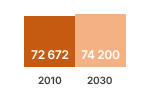 | Electricity (TWh/a) 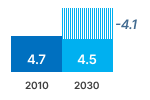 |
GHG-EMISSION 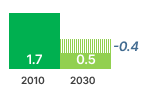 | CONSUMER EXPENSES 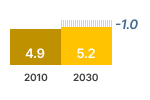 | REVENUES 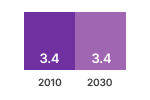 |
Source: estimations from the Ecodesign Impact Accounting Overview Report 2024
In 2020, 74 million games consoles were in use in the EU27, implying 38 consoles per 100 EU households.
On average, the consoles were actively used for 2.8 hours per day, for an EU27 total of 75 billion hours per year.
For 21.2 hours per day the consoles were inactive, in various low-power modes, for a EU27 total of 575 billion hours per year.
In 1990, sold consoles had an average power of 22 W. Without measures, this would have increased to 86 W in 2020, due to an increase in speed, memory, video quality and additional features. Due to the Voluntary Agreement between producers (VA, in Ecodesign context), the 2020 power was reduced to 72 W, a saving of 16% on the electricity consumption in active modes.
As regards the inactive modes, without measures the average power would have been 5.3 W in 2020, while the combination of the VA and the Ecodesign regulation on standby reduced it to 1.4 W (-74%).
In addition, due to Auto Power Down requirements, 0.6 hours per day shifted from full-power mode to low-power mode.
In 2020, the combined measures saved 4.0 TWh (47%) of electricity, half on active modes and half on inactive modes. In 2030 this is projected to remain more or less the same.
The savings are 0.17% of the total EU27 electricity consumption in 2020, and close to the consumption of Cyprus in 2020.
Due to Ecodesign measures, EU27 users saved € 0.8 billion on games consoles in 2020, projected to increase to € 1 billion in 2030, a 17% saving.
In 2030, the annual household expenses for games consoles decrease from € 31 to € 26.
Expected Savings
Electricity consumption
The electricity consumption by games consoles increased from 4.7 TWh/a in 2010 to 5.1 TWh in 2020 and projected to decrease to 4.5 TWh in 2030. The initial rise is partly due to an increase in functionality (and thus power) of new models. As this added functionality becomes standard, technology improvements result in lower electricity consumption in following generations. Savings due to the VA and standby regulations are estimated to be stable at 4 TWh/a from 2020.
Source: estimations from the Ecodesign Impact Accounting Overview Report 2024
Documents
- 18 DECEMBER 2023
- 18 DECEMBER 2023
- 18 DECEMBER 2023

Policy
The Games Consoles Voluntary Agreement (also referred to as the Self-Regulatory Initiative, SRI) aims to reduce the environmental impact of games consoles over their life cycle and to achieve energy savings and material efficiency through better design, thus benefiting the environment without compromising console performance and gaming experience.
Find out more about the genesis of the Games Consoles Voluntary Agreement and its most significant milestones.

